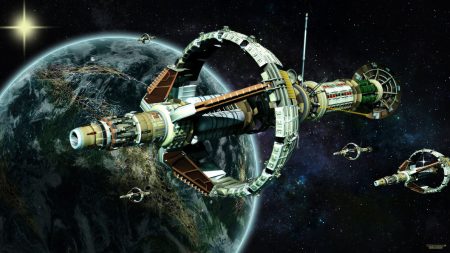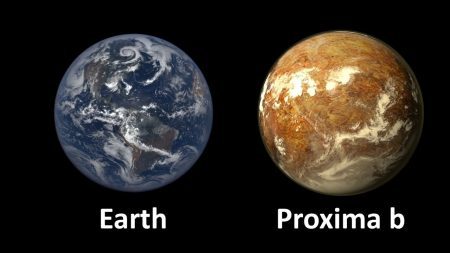September 20, 2018 – This morning I had a cortisone injection in my left knee which will keep me off my feet for the next 48 hours before normal life can resume. So I’m taking the time to look through all the items I have bookmarked and flagged as potential posting while lying here in our living room on the couch with an ice pack on my knee.
One subject that caught my eye several months ago seems like a natural follow up to the posting I wrote on September 17th about what the Monarch Butterfly could teach us about biological ways to succeed at interstellar travel. For humanity to send a reproducible population to a second Earth in a neighbouring solar system presents an enormous challenge for which we currently lack the knowledge and technology. Our imperfect understanding of population genetics and the dangers of interstellar space makes it highly improbable that we can pull this off without massive loss of life, and in the end without knowing if the people we send actually make it to their destination.
An astrophysicist at the University of Strasbourg, Frédéric Marin, has recently published a paper in which he works the success numbers for an interstellar crew complement taking a 6,300-year journey to Proxima Centauri-b, the planet referenced in my previous Monarch Butterfly posting.
Why 6,300 years? Marin chooses an optimal speed for the spacecraft of better than 500,000 kilometers per hour, three times faster than the Juno spacecraft currently circling Jupiter. At that speed the 40-trillion-kilometer voyage would last more than 6 millennia.
Marin looks at parameters for survival including issues like sudden death, accidents, space rock collisions, cosmic rays, infertility, inbreeding, pandemics and unforeseen random events. Applying a Monte Carlo simulation, a program called Heritage, Marin recently ran several different population configurations to determine the optimal minimal number needed to survive a multi-generational voyage. If you are unfamiliar with Monte Carlo simulations, these were first conceived by scientists who were working on the Manhattan Project to help them use quantitative analysis to predict a range of possible and probable outcomes.
Marin, who normally simulates remote galaxies and black holes, used Heritage beginning with 50 humans made up of 25 breeding-aged pairs. At those numbers Heritage concluded a crew would not survive the voyage. He then raised the numbers incrementally testing each in the simulation. All scenarios up until the number 98 indicated failure with the human crew dying off before reaching Centauri-b. But at 98, Heritage predicted a 100% survival outcome.

With 98 healthy humans, the population would be self-perpetuating with enough diversity to make up for the lack of being able to remove old genes through emigration and introduce new ones by immigration. Marin’s spaceship simulation allows for the 98 to grow the population over the journey to 500 as the interstellar spaceship gets close to Centauri-b.
Even Elon Musk’s BFR, the largest passenger rocket ship being planned today wouldn’t be able to handle a crew of 98, 30 at best, according to those who have studied the specifications. So one can conclude that the infrastructure and self-sustaining, environmental requirements of an interstellar ship are well beyond our best technological skill sets today.
But the exercise regardless has merit Marin states: “The same elements are essential for any self-sustaining colony, so our code can easily compute the survival rate of a group of humans after a local or global catastrophe as well.” I guess one could call this good post-apocalyptic thinking.
But others tackling the same thought experiment have disputed the number. One of those is anthropologist Cameron Smith, of Portland State University in Oregon, who has come up with a minimum of 14,000 to a maximum of 44,000 as the right numbers for human survival through interstellar space.
In his study, Smith concludes that the unforeseen has to be accounted for such as sudden death by accident or disease involving a disproportionate number of either the female or the male population which would impact viable genetic diversity to ensure survival.
As an anthropologist, Smith uses Polynesian migration modeling which looks at the numbers needed for a small population to spread from one island to many throughout the Pacific Ocean. Smith states that Polynesian groups of up to 100 or fewer hunter-gatherers set out on long sea voyages to reach other islands. The Polynesians came in a series of waves. Many didn’t survive these journeys. Many died after arrival. But the total number of migrants amount to the tens of thousands. Otherwise colonization fails. The same can be said about the European colonization of the Americas, New Zealand, and Australia. Thousands died before sustainable populations were established.
Of course, neither Marin or Smith in their thought experiments considered altering the human genome of the crew to make the voyage survivable. In my Monarch Butterfly article, I theorized that advanced genetic engineering would allow us to alter the species and make us genetically flexible. We could even go through a metamorphosis turning into chrysalides to emerge before making landfall at a new planet. On a trip to Centauri-b we would thus minimize many of the risks that both Marin and Smith accept as necessary to human migration over the long distances and perils of interstellar space.









